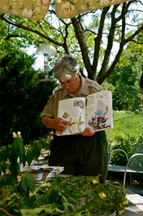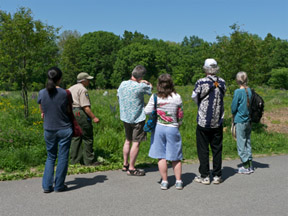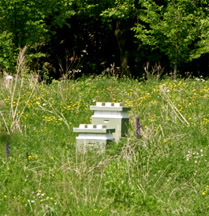May 23, 2010
Bees and Trees: How Insects and Trees Interrelate at Fresh Pond
Left Photo - Program participants sat at the Maynard
Ecology Center Patio and listened to Ranger Jean Rogers explain the
process of pollination. Cross pollination (allogamy) occurs when pollen
is transferred to a different plant. Pollination (fertilization) can
occur by wind, water, but the most common pollinators are animals (bats,
birds, ants, bees/wasps, beetles, butterflies/moths, and flies) with
insects predominating. Images (visual aids) were used to help participants
better understand the process of bee fertilization. When a worker bee
lands on a flower, it searches for, then drinks, nectar. As it feeds,
pollen from the anthers sticks to the soft hairs on the bees' body.
When the bee feeds on another plant's flower, the process of fertilization
begins as the the stigma receives the pollen.
Middle Photo - Program participants walked to the
beehive located in Neville Woods. Participants viewed the beehive located
in Neville Woods, then walked downthe Beech Path to Perimeter Road and
stopped at the edge of Lucitania Meadow. There are two beekeepers who
maintain the two beehives at Fresh Pond. Peter (third from left, pointing)
describes the beehive structure, bee behavior (worker, drone, queen,
et al) and hive activities to participants. Jeremy Angier is the other
beekeeper (not shown).
Right
Photo - Here is a close up of Lucitania Meadow's beehive which
is maintained by Jeremy Angier. Peter maintains the beehive in Neville
Woods. The bees at Fresh Pond Reservation are not aggressive, therefore
it is highly unlikely that they will sting.
Description and Photo by Carol Collura





